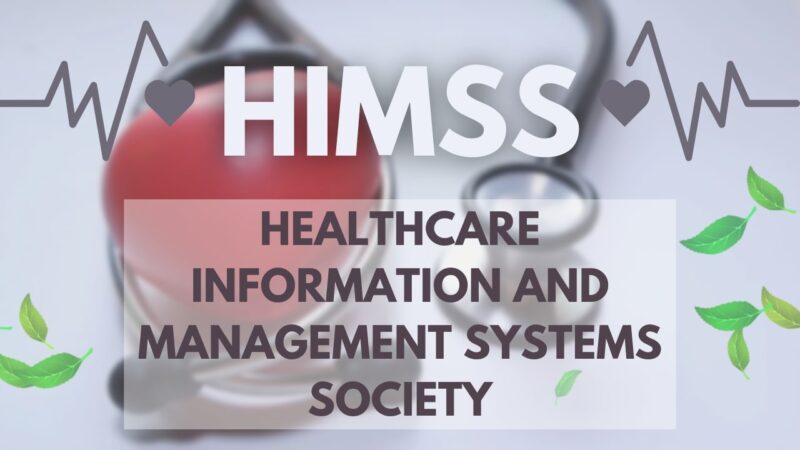The Healthcare Information and Management Systems Society (HIMSS) is a nonprofit entity that aims to advance the optimal utilization of IT and management systems in the healthcare sector. The organization offers thought leadership, professional and workforce growth, and public policy. Its annual conference, held during winter, is well-known and attracts tens of thousands of participants.
HIMSS comprises over 70,000 individuals, 630 corporations, and 450 nonprofit organizations as members, as stated on its website. Its volunteer board of directors, serving three-year terms, is made up of elected members who are chosen by the organization’s membership.
As a nonprofit, they generate income through advertising, data and publication sales; exhibits and educational events; membership dues; and other sources.
HIMSS’ main office is located in Chicago, with additional offices in Washington, D.C., Germany, and Singapore. The organization also operates a philanthropic branch, the HIMSS Foundation, which concentrates on charitable contributions, education, and research. The government affairs staff of their advocates for health IT policy to U.S. government officials and supports members by supplying background research and legislative information.
Before you delve into the world of healthcare information management with HiMSS, you may also be interested in learning about another key organization in the field, which plays a crucial role in shaping health information management practices and standards.
HIMSS Mission

HIMSS’ mission is to improve healthcare through the effective use of information technology and management systems. The organization strives to drive innovation, enhance patient outcomes, and promote collaboration within the healthcare industry.
By providing thought leadership, professional development, workforce growth, and public policy advocacy, they aim to create a transformative impact on the global healthcare landscape.
Goals
The goals of HIMSS include:
- Promoting the effective and innovative use of healthcare information technology and management systems to improve patient care and outcomes.
- Fostering collaboration among healthcare professionals, IT experts, and industry stakeholders to create a more efficient and connected healthcare ecosystem.
- Advocating for public policies that support the advancement of health IT and data-driven decision-making in healthcare.
- Providing thought leadership, resources, and educational opportunities to support the professional development and growth of the healthcare workforce.
- Encouraging the adoption of interoperable, secure, and patient-centered health IT solutions that empower individuals to actively engage in their own care.
- Facilitating global knowledge sharing and collaboration to drive continuous improvement in healthcare delivery and outcomes.
- Supporting research and innovation in health IT and management systems to address current and emerging challenges in healthcare.
- Engaging in philanthropic efforts through the HIMSS Foundation to advance education, research, and charitable initiatives in the healthcare field.
HIMSS is not involved in the endorsement of, or selection of, any of the EHR systems featured on the AmericanEHR Partners website.
Dedication to better health through information and technology.
While examining the impact of HiMSS on healthcare information management, it’s worth exploring another influential organization, which is dedicated to advancing the field of rheumatology and improving patient care.
Collaborations

- Interoperability Showcase: HIMSS collaborates with industry partners, healthcare providers, and technology vendors to organize the Interoperability Showcase at the annual HIMSS Global Conference. This interactive exhibit demonstrates how interoperability among health IT systems can improve patient care and streamline healthcare operations.
- Digital Health Indicator (DHI): In partnership with the Digital Health Collaborative, HIMSS developed the Digital Health Indicator, a tool to help healthcare organizations measure their digital health maturity and identify areas for improvement. The DHI assesses four critical dimensions of digital health – technology, data, process, and people.
- The Integrating the Healthcare Enterprise (IHE): they partnered with the Radiological Society of North America (RSNA) to create the Integrating the Healthcare Enterprise (IHE), an initiative that promotes the adoption of standards-based interoperability solutions to improve patient care.
- Personal Connected Health Alliance (PCHAlliance): collaborates with the Personal Connected Health Alliance, an organization dedicated to advancing the adoption of personal connected health technologies. PCHAlliance focuses on fostering innovation, engaging consumers in their own care, and transforming healthcare delivery.
- Health Story Project: HIMSS collaborates with the Health Story Project, a cooperative effort that brings together healthcare organizations, health IT vendors, and standards development organizations to accelerate the adoption of structured electronic health records. This project aims to improve the quality, safety, and efficiency of patient care by promoting the exchange of health information.
- The Global Consortium for eHealth Interoperability: They are a founding member of the Global Consortium for eHealth Interoperability, a public-private partnership that aims to promote global health IT interoperability. This consortium includes organizations such as the World Health Organization (WHO), the International Telecommunication Union (ITU), and the European Commission, among others.
History

The history of the Healthcare Information and Management Systems Society (HIMSS) dates back to 1961, when it was founded as the Hospital Management Systems Society. The organization initially focused on the needs of hospital administrators and professionals who were responsible for managing healthcare information systems. Over time, HIMSS expanded its scope to encompass various aspects of health IT and management systems within the broader healthcare industry.
Throughout its history, they have been committed to promoting the effective use of health IT and management systems to improve patient care and outcomes. The organization has achieved this goal by providing thought leadership, professional development opportunities, and public policy advocacy.
Some key milestones in HIMSS’ history include:
- In 1986, the organization changed its name to the Healthcare Information and Management Systems Society, reflecting its broader focus on the entire healthcare sector.
- In 1993, HIMSS held its first annual conference, which has since become a premier event in the health IT industry, attracting tens of thousands of attendees from around the world.
- In 2003, Their Analytics was launched as a subsidiary to provide healthcare organizations with data, analysis, and advisory services related to health IT and management systems.
- In 2004, HIMSS established the Foundation, its philanthropic arm, to focus on charitable giving, education, and research.
- In 2013, They acquired the Medical Group Management Association’s (MGMA) Health IT Conference, further expanding its offerings in health IT events and education.
- Throughout its history, HIMSS has played an active role in advocating for health IT policy in the United States and around the world, engaging with government leaders and policymakers to shape the future of healthcare.
Today, is a global organization with more than 70,000 individual members, 630 corporate members, and 450 nonprofit organizations as members. The organization continues to drive innovation and improvement in healthcare through its various initiatives, conferences, research, and collaborations.
FAQs
What are the benefits of becoming a HIMSS member?
Becoming a HIMSS member provides numerous benefits, including access to exclusive resources, networking opportunities, discounts on events and educational offerings, and the opportunity to influence health IT policy.
Members can also join various HIMSS committees and communities to share their expertise and contribute to the organization’s mission of improving healthcare through the use of information technology and management systems.
How can I get involved with them as a healthcare professional?
Healthcare professionals can get involved with HIMSS in several ways, including becoming a member, attending conferences and events, participating in webinars and educational programs, joining committees or communities, and contributing to thought leadership through articles, blogs, or podcasts.
They can also engage in advocacy efforts to help shape health IT policy at the local, regional, or national level.
How does HIMSS support the adoption of Electronic Health Records (EHRs)?
HIMSS supports the adoption of EHRs by providing resources, best practices, and case studies that demonstrate the benefits of EHR implementation. The organization also works to establish and promote interoperability standards to facilitate the seamless exchange of health information among EHR systems. Additionally, they conduct research to identify barriers to EHR adoption and develop strategies to overcome them.
How do they contribute to healthcare cybersecurity?
HIMSS contributes to healthcare cybersecurity by offering resources, guidelines, and best practices to help healthcare organizations protect their systems and patient data.
They also host events, such as the Healthcare Security Forum, where experts and stakeholders can discuss the latest cybersecurity trends, challenges, and solutions. Furthermore, advocates for policies and regulations that promote robust cybersecurity practices within the healthcare industry.
What is the role of the Foundation?
Foundation is the philanthropic arm of the organization, focusing on supporting education, research, and charitable initiatives in the healthcare field. The Foundation provides scholarships, grants, and awards to students, researchers, and healthcare professionals who demonstrate exceptional achievements or potential in health IT and management systems.
It also supports research projects that explore innovative ways to improve healthcare delivery and outcomes through the use of information technology and management systems.
How they engage with international stakeholders?
HIMSS engages with international stakeholders through its global offices in Germany and Singapore, as well as its participation in various international consortia, partnerships, and initiatives.
The organization also hosts international conferences and events, collaborates with international organizations like the World Health Organization (WHO) and the International Telecommunication Union (ITU), and offers resources and educational programs tailored to the specific needs and challenges of different regions around the world.
Find out how HIMSS helps bring transformation to healthcare
- Interoperability Call to Action
- HIT Resources & Tools
- Physician Community
- HIMSS Blog
- Join the HIMSS LinkedIn Group
- Twitter: Follow @HIMSS
- Listen to the Physician Podcast Series
Save the date
- 2/1/18 – Creating an Information Technology Enabled Culture of Safety in Acute Care Settings – Virtual Event
- 2/6/18 – Innovating Uses of Analytics to Improve Outpatient Primary Care Delivery – Virtual Event
- 3/15/18 – HIMSS – AMDIS Physician Executive Symposium in Las Vegas, NV
- 5/18/18 – 5/19/18 – 18 in Las Vegas, NV
- 5/18/18 – 5/19/18 – Precision Medicine Summit in Washington D.C.
- 6/11/18 – 6/12/18 – Healthcare Security Forum in San Francisco, CA
Subscribe to Complimentary Newsletters
- Medical Practice Insider – Business & technology intelligence for forward-thinking physician practices
- Clinical Informatics Insights – provider’s source for timely and comprehensive articles on effective integration of informatics across the continuum of care






